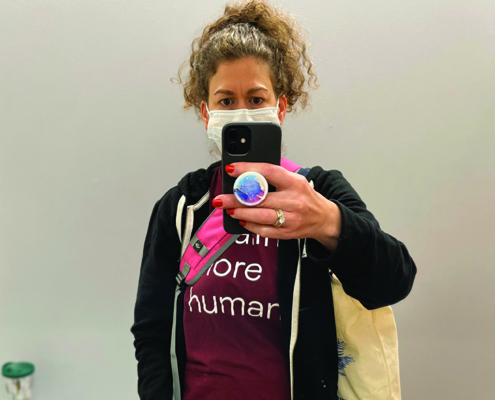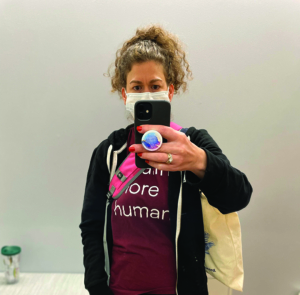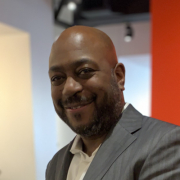Looking at provider communication through a new lens
Looking at provider communication through a new lens
By Andi Weiss
Monday, February 13, 2023, was a typical day for me as a healthcare marketer and busy mom of two, aside from having my yearly 3D mammogram. Fast forward a few days to Thursday the 16th, at 3:56 PM, which kicked off a scary period in my life. The “C word.” I’m lucky for many reasons – it was caught extremely early, treatment would cure it, and life would go on as usual after this blip. But I have to admit, at the time, I didn’t feel lucky at all. I was terrified.
February 16th was the start of countless appointments with surgeons and oncologists as I learned about my treatment options, all while juggling a full-time job and being there for my family. I have felt incredibly fortunate to be surrounded by a care team that is regarded as the best of the best in the medical community. My team also possesses the unique skill of communicating with me in a way that respects my autonomy and choice, and includes the right amount of empathy and humanity along the way.
Surgery was on my birthday at the end of March. The next day, I sent my surgeon a picture of me blowing out my birthday candles, and our dialogue on my patient portal is perhaps a perfect example of a provider meeting his patient (me) where she is at that moment. After all, I will be under his medical care for years to come, and this kind of authentic interaction is critical for fostering trust and connection.
Me: Dr. L! Wanted to say thank you for getting this cancer out of me on my birthday. I still managed to have a great night of takeout and cake. Pic attached from Friday at 9 PM!!!
Dr. L: That’s awesome! I’m glad I didn’t COMPLETELY ruin your birthday. I’ll call when the path report is available.
I’m certainly not suggesting that all patients should feel comfortable or even interested in communicating with providers in this way. This example simply highlights how one provider succeeds in showing up for me with empathy and authenticity. Having worked in the pharmaceutical industry for the last 15 years focusing on health behavior and patient support, I know that not all patients are as fortunate as I have been regarding their medical care team.
My experiences reflect an aspect of care with which many pharma companies and brands struggle. Clients have been coming to us for years with the challenge of how to improve the dialogue between patients and providers. They often recognize how important this communication is to the overall experience for patients, but don’t know what they can do to make it better. And while my own cancer journey has given me a new perspective on my communication preferences, it has also shed light on how other patients may absorb risk information and how much involvement they prefer in making treatment decisions. Empathy is the key that opens the door to interactions that convey the humanity that is often missing for patients in their provider relationships. I suspect that many providers would consider themselves empathetic; however, it’s not always evident in how they communicate.
I was interested to learn recently that this is another challenge artificial intelligence (AI) is trying to tackle. In a study published in JAMA in April titled “Comparing Physician and Artificial Intelligence Chatbot Responses to Patient Questions Posted to a Public Social Media Forum,” a team of healthcare professionals compared responses to patient questions generated by AI to those from actual providers.1 They evaluated both the quality and empathy of the responses and found the AI-generated responses to be significantly more empathetic and of higher quality than the responses from actual HCPs.
When I compared the physician and chatbot responses myself, one key difference stood out. Chatbot responses took advantage of the behavioral techniques that research has shown to be effective in forging trust and helping patients feel understood and valued – the same strategies that we train providers to use to help them communicate more effectively with empathy. Some examples include:
- Normalizing patient experiences before sharing new information. This helps patients feel less alone in what they’re going through and primes them to take in the new information.
- Validating patient concerns to show an acknowledgment that you’ve heard them.
- Communicating the value of self-monitoring to help patients stay on top of symptoms and side effects.
It’s not all that surprising that, in this study, providers preferred AI-generated responses over actual human responses. And at the same time, it’s not uncommon to hear patients complain that providers aren’t listening to them, that they feel rushed during the clinical encounter, or that they just don’t trust their doctors. Many providers may know that empathetic communication is important and may even be able to identify what “good” looks like. But that knowledge doesn’t always translate to the way they communicate in the real world. Now the question is, what can we, as pharma marketers, do to help improve real-world communication?
The first step is to answer some key questions about our audience to help us better understand their day-to-day experiences, challenges, and work environments. Questions may include:
- If providers are not communicating in a way that they know is optimal, why aren’t they?
- What are the barriers, either internally or in their environments, that are getting in the way? And how can we help providers overcome these barriers?
- Where are providers turning for support? Are they getting what they need there?
- What channels are most often used and what are providers looking for in different places?
- If we can’t overcome the barriers they face, what can we do to lessen the impact of them?
- What do we know about providers’ day-to-day experiences that might be getting in the way of personalizing their care to patient needs?
After gathering this data, we’re better positioned to plan out a solution that we know will positively influence provider behavior. However, if we find that institutional barriers are getting in the way, we need to think about what more we can do to overcome them.
The current research is expanding how we think about the support needed for providers. We need to consider solutions that help them save time and better meet patient needs. For example, the current research suggests that AI could be used to generate a first draft of responses to patient questions that providers could then further modify, cutting down on the time providers spend crafting messages from scratch and ensuring responses to patients are grounded in empathy. The authors discuss the possible implications of this, which might include increased efficiency in managing patient needs and potentially reducing provider burnout. However, skill-building is also critical to ensure those in-the-moment exam room conversations are grounded in empathy as well. Imagine a behavioral-based provider solution that fits into their natural workflow. Such a solution could build provider skills to better meet the needs of patients while also lessening the impact of institutional barriers they face daily, like packed patient schedules and limited time to respond to patient queries.
It would be unfair to expect all providers to communicate like mine. Perhaps my doctor received skill-based communication training, and maybe he is given more time per patient encounter. And no doubt many providers would be unhappy being compared to AI. Solutions that build skills and train providers to work with technology may be just what is needed to ensure maximum impact. Cracking the code on this has far-reaching implications for the patient experience with treatment, and it is absolutely worth the time and resources to dig in further.
I am progressing in my treatment, and I am extremely grateful that my cancer was caught early and is curable. I’m so thankful for the empathy and care that my medical team has given to me and for the patience they’ve shown through each step of my journey.
Reference
- Ayers, J.W., et al. Comparing physician and artificial intelligence chatbot responses to patient questions posted to a public social media forum. JAMA Intern Med. [published online April 28, 2023]. doi:10.1001/jamainternmed.2023.1838
Andi Weiss is VP, behavioral services at Evoke MicroMass.













